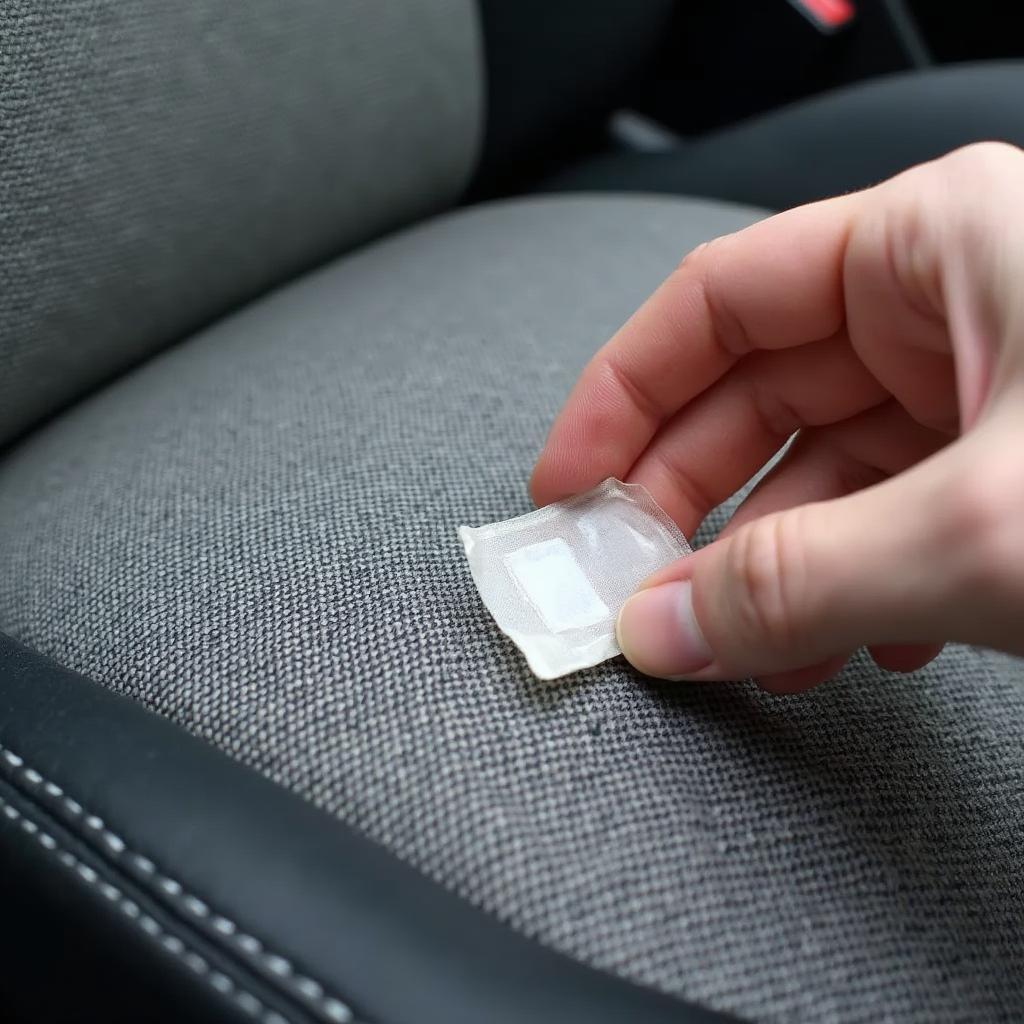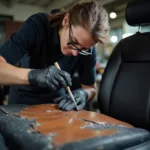Discovering a hole in your car seat fabric can be frustrating, but it’s a common issue. Whether it’s from wear and tear, accidental punctures, or mischievous pets, that hole doesn’t have to mean an expensive trip to the auto upholsterer. With a few simple tools and some patience, you can learn how to repair a hole in car seat fabric and have your interior looking its best again.
Assessing the Damage: What You Need Before You Start
Before diving into the repair, it’s crucial to assess the extent of the damage. A small cigarette burn will require a different approach than a large tear caused by a sharp object.
- Inspect the hole: Is it a clean cut or a ragged tear?
- Check for underlying damage: Are there any exposed springs or foam padding?
- Consider the fabric type: Is it cloth, leather, or vinyl?
Once you have a clear understanding of the damage, you can gather the appropriate materials for your repair.
Simple Solutions for Minor Holes and Tears
For small holes and tears, often a simple patch or filler will suffice.
Using an Iron-On Patch: A Quick Fix for Fabric Seats
Iron-on patches are readily available at most craft and fabric stores and offer a quick and easy solution for small holes and tears in fabric car seats.
- Choose a patch: Select a patch that closely matches the color and texture of your car’s upholstery.
- Prepare the area: Clean the area around the hole with a mild fabric cleaner and let it dry completely.
- Apply the patch: Place the patch over the hole, adhesive side down, ensuring it lies flat and smooth.
- Iron it on: Cover the patch with a thin cloth and iron over it according to the package instructions. The heat will melt the adhesive, bonding the patch to the fabric.
Filling the Void: Fabric Repair Kits for Larger Holes
For larger holes or tears in fabric seats, a fabric repair kit can be a more effective option. These kits usually contain a specialized adhesive and fabric patches that you can cut to size.
- Clean the area: Thoroughly clean the damaged area with a fabric cleaner and allow it to dry completely.
- Prepare the patch: Cut a patch from the kit’s fabric slightly larger than the hole, ensuring it covers any frayed edges.
- Apply the adhesive: Following the kit’s instructions, apply the adhesive to the back of the patch and carefully position it over the hole.
- Secure the patch: Use weights or clamps to hold the patch firmly in place while the adhesive dries.
“When choosing a fabric repair kit, opt for one that is specifically designed for automotive upholstery,” says John Davis, a seasoned automotive upholsterer with over 20 years of experience. “These kits are formulated to withstand the wear and tear that car seats endure.”
Advanced Techniques for Significant Damage
For significant damage, such as large tears, burns, or holes with exposed padding, more advanced repair techniques are necessary. These often involve sewing or patching from the underside of the fabric.
Sewing a Patch: A Durable Solution for Skilled DIYers
If you’re comfortable with basic sewing, sewing a patch offers a durable and less noticeable repair.
- Choose a matching fabric: Find a fabric that closely matches the color, texture, and weight of your car’s upholstery.
- Prepare the patch: Cut a patch from the fabric, ensuring it’s slightly larger than the hole on all sides.
- Thread your needle: Use a heavy-duty thread that matches the fabric color.
- Sew the patch: Using a curved needle, carefully sew the patch to the underside of the torn fabric. Try to keep your stitches small and even for a professional-looking finish.
Seeking Professional Help: When to Call in the Experts
While many car seat repairs can be tackled with DIY methods, some situations call for professional intervention. If the damage is extensive, involves complex mechanisms like seat heaters or airbags, or if you’re not comfortable with the repair process, it’s best to consult a qualified automotive upholsterer.
Conclusion
Repairing a hole in your car seat fabric doesn’t have to be a daunting task. By understanding the type of damage and choosing the appropriate repair method, you can restore your car’s interior to its former glory and extend the life of your seats. Whether you opt for a quick fix with an iron-on patch or choose a more involved sewing project, tackling this repair yourself can save you money and give you a sense of accomplishment.



